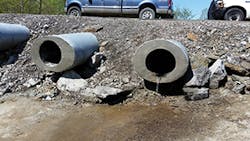White County, AR, located in the northwest corner of the state, was facing a problem with existing culverts that were past their designed life expectancy. They were beginning to rust and deteriorate, causing void areas to occur outside the pipe.
Scott Brignac of ISCO Industries explains that at a trade show in 2013, a White County judge had seen ISCO’s Snap-Tite product and remembered it. “The judge was having some problems in these stormwater areas, and had seen our product the year before, so he gave us a call.”
Brignac offered to come in person to see the problem areas so he could offer a proper solution, and the judge, responsible for deciding how to proceed, accepted his offer.
“I went and did a presentation. What he originally was concerned with was a road called Fisher Hill Road. This road had five culverts, 60-inch diameter, about 30 feet long each. It served as a bridge structure.
“Some voids had been caused because of the deteriorated culverts, and part of one end of the road actually caved in. The void had washed out so badly that there was nothing holding the concrete any more in that area. It just fell in.
“After the presentation, it prompted him to start thinking about other areas that they really hadn’t been thinking about. That’s when the Lakeview Estates project came to mind. He told us that they had just repaved the road in question about a year ago, and he made it clear that he was not going to tear up that road to go fix the culverts under the road. He was thinking that the culverts should have been fixed at the same time that the road was repaved.
“We went to look at Fisher Hill Road, and the other road in Lakeview Estates. The Lakeview Estates road was in a subdivision with only one way in and one way out. We come across that scenario a lot. The problem is that you cannot shut down the street for any amount of time, because of emergency issues.
“The judge asked for three separate quotes. The first quote was for Lakeview Estates, but only for four of the nine culverts in the road. These four were obviously deteriorating, causing voids. But I told him that if we are going to be here doing these four culverts, you might as well do the rest of them. Although they weren’t showing immediate signs of failing, they are going to fail sooner or later. Either you’ll have to dig them up, or you’ll have to call us to come out and replace them, and you’re going to have to spend more money.
“He then asked for a separate quote on doing those other culverts, and he also wanted a quote for taking care of the culverts on Fisher Hill Road.
“After talking to the installation contractor, I gave the judge an estimate for doing a turnkey job, and I explained to him that if he did all three jobs at one time, we could save him about $10,000. This is in addition to the savings he has from using our Snap-Tite liner rather than digging up and replacing his culverts.”
Brignac got the complete job.
On Fisher Hill Road job, there were five existing culverts, each 60 inches in diameter and 30 feet long.
“On this project, we sent them 24-foot lay lengths of the Snap-Tite HDPE pipe. That’s the standard size they come in. But we can make sections from two-foot pieces to 50-foot pieces.
“The pieces have male and female ends, and they just snap together using some chains and come-alongs, and you ratchet them in place.”
Brignac says weather played a factor in the project. “On Fisher Hill Road, the bridge crossed over a good-sized creek. This creek is steadily flowing all the time, but there had been a lot of rainfall during the project that prevented the work crews from doing anything, so we had to dam off the inlet side to stop the water from flowing so we could get the pipes in there and do our grouting. Once we got the pipes in place and applied the grout, it only took a couple of days.
“When we insert our pipe into the existing culvert, we build concrete bulkheads on both ends of the pipe, on the inlet and the outlet. That serves to hold the pipe in place. When we pump in our grout, to fill in the annular space between the two pipes, it keeps that grout from coming out. It fills in that whole void.
“When we pump in the grout,” he continues, “it’s not only filling in the annular space between the two pipes, it’s also filling in all the void areas that have been caused by the deteriorating pipe. For example, with that road that failed, we pumped grout in that whole area, and essentially built them a new concrete bridge for that part of the road.
The Lakeview Estates portion of the job involved five oval-shaped, 40-foot-long culverts measuring 29 by 42 inches. These were relined with 24-inch round Snap-Tite pipes. For another two oval culverts, each 20 by 28 inches and 50 feet long, and for one 40-foot-long, 24-inch-diameter round culvert, 18-inch round Snap-Tite pipes were used. A 40-foot-long, 36-inch-diameter round culvert was relined with a 28-inch round Snap-Tite pipe.
According to the White County judge, this relining solution cost perhaps a fifth of what it would have cost to dig up and replace the culverts. In addition, with the pipe liners, there was no interruption to traffic on the only road serving the Lakeview Estates subdivision. Digging up the culverts likely would have closed the road for at least three days.
Brignac explains why the county judge was the person with the responsibility of deciding how best to deal with the failing culverts.
“In Arkansas, the county judge is the decision maker. I cover four states—Louisiana, Arkansas, Oklahoma, and Texas—and all of them are different. In Oklahoma, it’s the county commissioners that make the decisions. Here in Louisiana, it’s totally different. We have parishes here, not counties.
“Some of these parishes have a form of government with a parish president, a council, a public works director, a streets director, a drainage director, and so on. The decision maker is different for every parish.”


